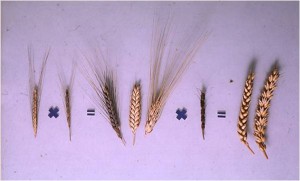(November 28, 2018) Editor’s Note: The Federal Government and representatives of the three giant agro-chemical-seed companies are working to take control of seed genetics away from prairie farmers and the Canadian public. The following compilation of two articles by my late friend and colleague Paul Beingessner about how grain and other food genetics are created by farmers is more pertinent than ever. This article is reproduced from our Public Plant Breeding page.
Shared knowledge and co-operation make progress possible
– Paul Beingessner
Cross breeding of plants to produce new varieties is a relatively recent science, little more than 100 years old. Improving plant varieties by selection, on the other hand, has been going on for about 10,000 years. All modern plant breeding, is built on that first 10,000 years during which farmers around the world created an astounding legacy.
And what did farmers do in those 300 generations? Well, they developed modern crops. By careful selection, they turned tiny seeds of grasses and small wild fruits into grains and vegetables and fruits, many of which we still grow and eat today. They developed hundreds of breeds of cattle, sheep, goats and other animals suited to the wide range of climates around the globe. And they did all this before the discovery of the science of genetics, which is just a bit over 100 years old.
One hundred years ago, no one owned plant varieties. Plant breeders around the world co-operated by sharing germplasm and passing on new discoveries. The creation of Marquis wheat, forerunner of nearly all bread wheats in western Canada, illustrates how plant breeders built on the legacy left by generations of farmers.
Marquis is a cross between Red Fife and Hard Red Calcutta. Red Fife was brought from Scotland, by a farmer who got the seeds from a Polish ship that carried wheat from the Ukraine. It was given to another Scottish farmer in Ontario, David Fife.
Hard Red Calcutta came from India, but it was a type of wheat rather than a single variety. Crossed with Red Fife and carefully selected for several generations, it yielded Marquis wheat. By 1918, Marquis was grown on more than 20 million acres, from northern Saskatchewan to southern Nebraska. James Boyle of the College of Agriculture at Cornell University said this about Marquis wheat: “The greatest single advance in wheat ever made was the introduction of that class of hard spring wheat known as Marquis wheat. The idea came free of charge from the Dominion of Canada’s Cerealist, Sir Charles E. Sanders (sic).”
The development of Marquis wheat is a story of co-operation. Co-operation, whether wittingly or not, between farmers of that day in Poland, the Ukraine, Scotland, India, Canada and the United States, and farmers from thousands of years before, whose careful work in selecting and preserving wheat seeds made all the other co-operation possible. This co-operation occurred because people recognized the importance of progress and development, and they knew it would only happen if people shared their knowledge.
For 300 generations, ten thousand years, farmers kept this knowledge and passed it on. And now, in our generation, the chain is being broken. Farmers are leaving the land in droves. Why? Because we gave up our control over that knowledge. As modern science evolved, we gave it to the universities. But they were publicly owned, and as they improved on that knowledge, they gave it back to us, freely.
Then, about 20 years ago, there was a dramatic shift. Governments decided that knowledge should no longer be free. They brought in plant breeders’ rights and patents on living things. Now, by adding one tiny jot to the information that came from 300 generations of farmers, private companies and even the universities themselves could own the knowledge built up over 10,000 years. And once they had it, they began to sell it back to us, to use, not to own. Now farmers are forbidden from saving their own seeds and giving them to their neighbours, as they did for millennia.
But we did all this for a reason, right? We did it because science and the privatization of knowledge were going to give us better crops, make us better off, and allow us to feed the expanding global population.
So we look for solutions. Ethanol, bio-diesel, WTO, hog barns, higher yielding crops, genetically modified plants and animals. Strangely, 400 million people still die of hunger each year, while a billion have inadequate diets. Farmers all over the globe are in trouble, fleeing to overcrowded cities and abandoning the practices of 300 generations.
The patenting of plants, far from encouraging innovation, as is the purpose of patents, is now used to stifle innovation. It allows companies to tie up germplasm for their exclusive use. While plant breeders’ rights do not now allow a breeder to restrict further work using his creation, patents do. Farmers must let their voices be heard.
© Paul Beingessner 2004 and 2006
Who will control the legacy of 300 generations of crop genetics?
The Canadian tradition has been to build on this legacy in the public interest. Farmers and the Canadian public have provided the funding for scientists working at public universities and Federal Government Agricultural Research stations to continue developing new varieties of wheat and other grains.
Next time look for a background on the latest attempt by the agricultural chemical industry to hijack control of the genetics of our daily bread and other foods.


